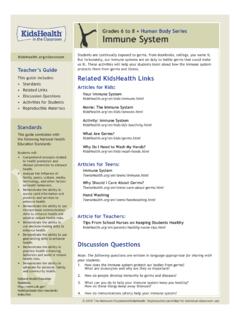Transcription of Control Options for Lesser Celandine - Wa
1 Control Options for Lesser Celandine General Information Lesser Celandine , also called fig buttercup, is a native of Europe, Asia and North Africa. It has been introduced into North America as a garden ornamental. It invades moist woodlands, forming a dense monoculture very early in the spring. Although the foliage dies back by June, a dense network of underground roots and tubers remain, inhibiting the growth of native flowers. Lesser Celandine reproduces by seed, bulblets and underground tubers, and can easily be spread when soil is disturbed or moved. The bulblets, which are produced on the stem, can also be spread by floodwaters and heavy rain. Many varieties of Lesser Celandine are still sold as garden ornamentals, with flower color ranging from white to orange, and foliage ranging from green to bronze. Manual/Mechanical Techniques Any method of Control for Lesser Celandine will require persistence and monitoring.
2 Small infestations of Lesser Celandine can be controlled by hand digging. Care must be taken to remove as much of the plant material (including all root material, bulblets and tubers) as possible. Removed plant parts should be bagged and disposed of as garbage and should never be composted. Follow up work will be required to Control any plants that develop from missed plant parts. Chemical Recommendations Lesser Celandine can be managed using specific the plant is often growing with other desirable plants and grass, care should be taken not to injure off-target using herbicides, always read and follow label directions for rates, spraying conditions, personal protective equipment and grazing intervals. Do not spray when it is windy or raining, or when rain is forecast. Herbicides should not be sprayed within 60 feet of water bodies and creeks, without further consultation with the Noxious Weed Board.
3 Remember, it is the herbicide applicators responsibility to apply the product in accordance to the instructions on the label. Herbicides which contain the active ingredient glyphosate are effective in controlling (but not necessarily eradicating) Lesser Celandine . However, application timing and herbicide concentration must be correct to obtain Control . Application should be made in late winter or early spring when leaves are visible, but prior to full flowering, and when temperatures are above 40 F. Apply a 1 to rate of a active ingredient glyphosate. An added non-ionic surfactant will improve herbicide uptake by the plant. Glyphosate will impact other vegetation so try to target only the Celandine . It may take 1-2 weeks before the full effects of the treatment are visible. The site should be monitored and retreated in subsequent years, as needed. Herbicides containing triclopyr may also be effective in controlling Celandine .
4 NEVER apply herbicides to standing water unless they are distinctly labeled for aquatic use. Ingredients in these products may be toxic to fish. Always read and understand the label of the herbicides you choose to use. More is NOT better when using herbicides, and may actually hinder the ability of the herbicide to injure the target plant if the solution is too strong. This wastes money and effort and puts more product into the environment than is necessary. ALWAYS follow the recommended rates on the label. With all herbicides, when you apply them is as important as how you apply them. The mention of a specific product brand name in this document is not, and should not be construed as an endorsement or as a recommendation for the use of that product. Herbicide information is taken from the WSU Pacific Northwest Weed Management Handbook and King County Noxious Weed Program.
5 Whatcom County Noxious Weed Board 322 N. Commercial St, Suite 110 Bellingham WA 98225





